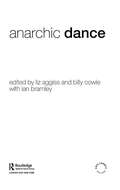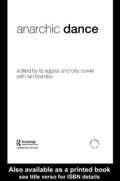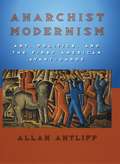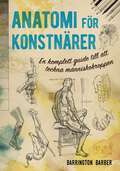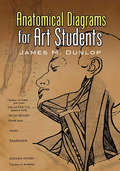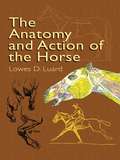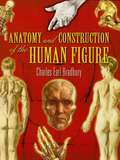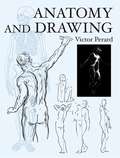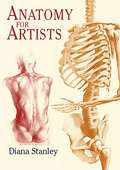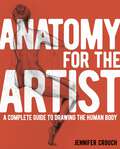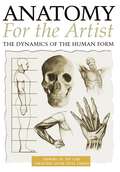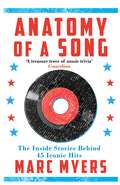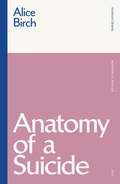- Table View
- List View
Anamorphosis in Early Modern Literature: Mediation and Affect (Literary and Scientific Cultures of Early Modernity)
by Jen E. BoyleAnamorphosis in Early Modern Literature explores the prevalence of anamorphic perspective in the seventeenth and eighteenth centuries in England. Jen Boyle investigates how anamorphic media flourished in early modern England as an interactive technology and mode of affect in public interactive art, city and garden design, and as a theory and figure in literature, political theory and natural and experimental philosophy. Anamorphic mediation, Boyle brings to light, provided Milton, Margaret Cavendish, and Daniel Defoe, among others, with a powerful techno-imaginary for traversing through projective, virtual experience. Drawing on extensive archival research related to the genre of "practical perspective" in early modern Europe, Boyle offers a scholarly consideration of anamorphic perspective (its technical means, performances, and embodied practices) as an interactive aesthetics and cultural imaginary. Ultimately, Boyle demonstrates how perspective media inflected a diverse set of knowledges and performances related to embodiment, affect, and collective consciousness.
Anamorphosis in Early Modern Literature: Mediation and Affect (Literary and Scientific Cultures of Early Modernity)
by Jen E. BoyleAnamorphosis in Early Modern Literature explores the prevalence of anamorphic perspective in the seventeenth and eighteenth centuries in England. Jen Boyle investigates how anamorphic media flourished in early modern England as an interactive technology and mode of affect in public interactive art, city and garden design, and as a theory and figure in literature, political theory and natural and experimental philosophy. Anamorphic mediation, Boyle brings to light, provided Milton, Margaret Cavendish, and Daniel Defoe, among others, with a powerful techno-imaginary for traversing through projective, virtual experience. Drawing on extensive archival research related to the genre of "practical perspective" in early modern Europe, Boyle offers a scholarly consideration of anamorphic perspective (its technical means, performances, and embodied practices) as an interactive aesthetics and cultural imaginary. Ultimately, Boyle demonstrates how perspective media inflected a diverse set of knowledges and performances related to embodiment, affect, and collective consciousness.
Anarchic Dance
by Liz Aggiss Billy CowieLiz Aggiss and Billy Cowie, known collectively as Divas Dance Theatre, are renowned for their highly visual, interdisciplinary brand of dance performance that incorporates elements of theatre, film, opera, poetry and vaudevillian humour. Anarchic Dance, consisting of a book and DVD-Rom, is a visual and textual record of their boundary-shattering performance work. The DVD-Rom features extracts from Aggiss and Cowie's work, including the highly-acclaimed dance film Motion Control (premiered on BBC2 in 2002), rare video footage of their punk-comic live performances as The Wild Wigglers and reconstructions of Aggiss's solo performance in Grotesque Dancer. These films are cross-referenced in the book, allowing readers to match performance and commentary as Aggiss and Cowie invite a broad range of writers to examine their live performance and dance screen practice through analysis, theory, discussion and personal response. Extensively illustrated with black and white and colour photographs Anarchic Dance, provides a comprehensive investigation into Cowie and Aggiss’s collaborative partnership and demonstrates a range of exciting approaches through which dance performance can be engaged critically.
Anarchic Dance
by Liz Aggiss Billy Cowie Ian BramleyLiz Aggiss and Billy Cowie, known collectively as Divas Dance Theatre, are renowned for their highly visual, interdisciplinary brand of dance performance that incorporates elements of theatre, film, opera, poetry and vaudevillian humour. Anarchic Dance, consisting of a book and DVD-Rom, is a visual and textual record of their boundary-shattering performance work. The DVD-Rom features extracts from Aggiss and Cowie's work, including the highly-acclaimed dance film Motion Control (premiered on BBC2 in 2002), rare video footage of their punk-comic live performances as The Wild Wigglers and reconstructions of Aggiss's solo performance in Grotesque Dancer. These films are cross-referenced in the book, allowing readers to match performance and commentary as Aggiss and Cowie invite a broad range of writers to examine their live performance and dance screen practice through analysis, theory, discussion and personal response. Extensively illustrated with black and white and colour photographs Anarchic Dance, provides a comprehensive investigation into Cowie and Aggiss’s collaborative partnership and demonstrates a range of exciting approaches through which dance performance can be engaged critically.
Anarchist Modernism: Art, Politics, and the First American Avant-Garde
by Allan AntliffThe relationship of the anarchist movement to American art during the World War I era is most often described as a "tenuous affinity" between two distinct spheres: political and artistic. In Anarchist Modernism—the first in-depth exploration of the role of anarchism in the formation of early American modernism—Allan Antliff reveals that modernists participated in a wide-ranging movement that encompassed lifestyles, literature, and art, as well as politics. Drawing on a wealth of hitherto unknown information, including interviews and reproductions of lost works, he examines anarchism's influence on a telling cross-section of artists such as Robert Henri, Elie Nadelman, Man Ray, and Rockwell Kent. He also traces the interactions between cultural figures and thinkers including Emma Goldman, Alfred Stieglitz, Ezra Pound, and Ananda Coomaraswamy. By situating American art's evolution in the progressive politics of the time, Antliff offers a richly illustrated chronicle of the anarchist movement and also revives the creative agency of those who shaped and implemented modernism for radical ends.
Anatomi För Konstnärer: En komplett guide till att teckna människokroppen
by Barrington BarberEftersom den är dynamisk och engagerande har människokroppen alltid varit ett populärt motiv för konstnärer, med ständiga utmaningar och många belöningar. Det här är en uttömmande anatomibok med allt du behöver veta för att skapa sanningsenliga och trovärdiga teckningar av människokroppen. Den tar upp benstrukturen, muskellagren och hudytorna för alla kroppsdelar och visar även hur mästare har gått till väga för att teckna olika typer av figurer. Bland innehållet finns krokiteckning, kroppen i rörelse och påklädning av människokroppen, och projekt som visar steg för steg hur man tillämpar anatomiska kunskaper för att skapa bra teckningar.Lär dig att:• Avbilda muskler och benstruktur som syns genom huden• A Känna igen musklerna som ger ansiktsuttrycken• A Teckna ett porträtt steg för steg• A Göra trovärdiga återgivningar av kroppen i rörelse• A Sätta ihop bra figurkompositioner
Anatomical Diagrams for Art Students
by James M. DunlopAny artist wishing to practice figure drawing or to understand the body's movement will do well to study the interaction of muscles with bone structure. This timeless introduction to human anatomy combines art and science, focusing on realistic depictions of the skeleton's impact on the external form and the attachments of the muscular system.More than 70 black-and-white illustrations show the positions and names of muscles and bones. Clear and accurate, the diagrams cover everything from the bones and muscles in the neck, head, trunk, limbs, hand, and foot to details of the face. Artists at every level of experience will find this volume an indispensable reference.
Anatomical Drawing: A Scenographic Intersection Between Science, the Visual Arts and Performance (Drawing In)
by Sue FieldIntersecting art, science and the scenographic mise-en-scène, this book provides a new approach to anatomical drawing, viewed through the contemporary lens of scenographic theory.Sue Field traces the evolution of anatomical drawing from its historical background of hand-drawn observational scientific investigations to the contemporary, complex visualization tools that inform visual art practice, performance, film and screen-based installations. Presenting an overview of traditional approaches across centuries, the opening chapters explore the extraordinary work of scientists and artists such as Andreas Vesalius, Gérard de Lairesse, Santiago Ramón y Cajal and Dorothy Foster Chubb who, through the medium of drawing dissect, dismember and anatomize the human form.Anatomical Drawing examines how forms, fluids and systems are entangled within the labyrinthine two-dimensional drawn space and how the body has been the subject of the spectacle. Corporeal proportions continue to be embodied within the designs of structures, buildings and visual art. Illustrated throughout, the book explores the drawings of 17th-century architect and scenographer Inigo Jones, through to the ghostly, spectral forms illuminated in the present-day X-ray drawings of the artist Angela Palmer, and the visceral and deeply personal works of Kiki Smith. Field analyses the contemporary skeletal manifestations that have been spawned from the medieval Danse Macabre, such as Walt Disney's drawn animations and the theatrical staging, metaphor and allegorical intent in the contemporary drawn artworks of William Kentridge, Peter Greenaway, Mark Dion and Dann Barber.This rigorous study illustrates how the anatomical drawing shapes multiple scenographic encounters, both on a two-dimensional plane and within a three-dimensional space, as the site of imaginative agency across the breadth of the visual and performance arts. These drawings are where a corporeal, spectacularized representation of the human body is staged and performed within an expanded drawn space, generating something new and unforeseen - a scenographic worlding.
The Anatomy and Action of the Horse
by Lowes D. LuardThis easy-to-read text explains the horse as a machine designed for movement. Using different colors in his drawings, the author not only describes with clarity the horse's skeleton and the functions of various muscles, but also creates images that have the power to suggest movement and stress. More than 75 illustrations include accurate diagrams and color illustrations fo the horse's anatomy, as well as meticulously rendered sketches of the entire animal.Of value to students and teachers of art, this book will also appeal to horse lovers who want a deeper understanding -- without having to examine the anatomical complexities of the subject -- of why this animal is capable of moving with such grace and speed.
Anatomy and Construction of the Human Figure
by Charles Earl BradburyTo draw or paint human figures truly, an artist must have as much understanding of bones and muscles as of form. This beautiful guide by a respected artist and teacher provides that knowledge. Realistic plates of bones and muscles show form and function, while full-color images make graphic distinctions between bone, muscle, and tendon. Drawings throughout the book emphasize fundamentals of anatomy and show simple methods of building the forms.Author Charles Earl Bradbury (1888-1967) takes a two-part approach in this book. The first part features a self-contained treatment of the bones of the skeleton and how they relate to the body's outline and muscle masses. The second focuses on muscles and their actions, showing how they are constructed and how they look in the human form. Male and female structures are compared and contrasted throughout the text. Designed specifically for classroom use, this volume is also a priceless reference.
Anatomy and Drawing
by Victor PerardThis instructive book presents excellent annotated line drawings of anatomical structure for the beginning artist. Explaining the subject in simple terms and with an extensive series of dynamic illustrations, the author identifies parts of the body and demonstrates a wide array of physical activities through his sketches. Following notes on proportion and drawing, chapters cover the human skeleton, head and neck, torso, arm, hand, leg, foot, and musculature. Numerous illustrations depict various views of these structures, movements of the human figure, as well as changes in the relative proportions of features at different ages. One of the best books in its field, Anatomy and Drawing helps demystify a complex subject by enabling students to visualize the muscles and bones under the skin, and covers just about everything a beginner needs to know about drawing the human anatomy.
Anatomy for Artists: The Complete Guide to Drawing the Human Body
by Barrington BarberDrawing the human figure with confidence and skill is perhaps the biggest challenge an artist can face, but it is the most rewarding when done successfully. In Anatomy for Artists, best-selling author and artist Barrington Barber provides clear annotated diagrams of every part of the human body useful to the artist, showing bone structure, musculature and surface views.Throughout the book he gives practical advice, gained from years of experience, on how to apply your newfound knowledge to the drawing of live models. This carefully researched, comprehensive book is an invaluable reference resource for the practising artist.Learn how to:• Recognize the differences between male and female bone structure• Identify facial muscles used in different expressions• Name the bones that show at the surface of the body• Accurately portray the body in movement• Improve your life drawing technique
Anatomy for Artists: A Complete Guide to Drawing the Human Body
by Barrington BarberDrawing the human figure with confidence and skill is perhaps the biggest challenge faced by artists, yet the most rewarding when it is achieved.In Anatomy for Artists, best-selling author and artist Barrington Barber provides clear annotated diagrams of every part of the human body useful to the artist, showing bone structure, musculature and surface views.Throughout the book he gives practical advice, gained from years of experience, on how to apply your new-found knowledge to the drawing of live models.Learn how to:• Recognize the differences between male and female bone structure• Identify facial muscles used in different expressions• Name the bones that show at the surface of the body• Accurately portray the body in movement• Improve your life drawing techniquePacked with over 400 drawings, this thoroughly researched and comprehensive book is an invaluable reference resource for the practicing artist.
Anatomy for Artists
by Diana StanleyConcise and uniquely organized, this outstanding guide teaches the essentials of anatomical rendering. Author Diana Stanley presents numerous illustrations and instructions covering the key aspects of anatomy, without the distractions of unnecessarily extensive technical details that many art students find discouraging. Four major sections constitute the book, with studies of the trunk, the head and neck, the upper limb, and the lower limb. Each section features full coverage of the skeleton, the muscles, and their surface forms. The emphasis throughout is on relating anatomical structure to the actual surface appearance of the body, both at rest and in motion. Sixty-four exceptionally clear and instructive illustrations include diagrams of skeleton and muscle structure, as well as superb examples of figure drawing. This affordably priced and easy-to-reference manual represents an invaluable addition to the library of every artist -- student and professional.
Anatomy for Fantasy Artists: An Essential Guide to Creating Action Figures and Fantastical Forms
by Glenn FabryAn indispensable guide for anyone interested in improving and developing their fantasy art figures. Fantasy artists are unlikely to use models to draw from life but, to be successful, their creations must have a grounding in reality. This book by successful comic and fantasy artist Glenn Fabry, teaches you the principles of anatomy, from musculature and skeletal structure through to movement. You can then develop your artistic style by breaking and bending the rules of anatomy through practical exercises and demonstrations, accompanied by incredible finished artworks. The step-by-step exercises help you to fully understand the subtle movements that combine to create expressions, and the flowing movements that constitute actions. Anatomy for Fantasy Artists trains you in creating professional quality illustrations for comic book art, graphic novels, fantasy posters, sci-fi book covers and illustrations, and even computer games. In this book you will find valuable instruction from experts in the field, expanded from the original edition with additional pages that feature many more how-to, step-by-step illustrations. Instruction starts with the basics of human anatomical drawing and musculature, facial expressions, hands and body language, and then follows with a review of the principles of perspective and composition. Subsequent sections instruct on ways to distort, develop, and transform the human figure, giving it features that range from monstrous or magical to super-agile or larger than life, including dynamic poses for superheroes and villans, as well as fantasy female poses. Detailed artist's references and step-by-step instructions show how to build bodies that truly stretch the imagination. You also learn how to render characters in many different dynamic action poses, such as flying, spinning, punching, and jumping, as well as how to express each character's emotions through facial expressions. The cast of characters includes wizards, ogres, werewolves, winged avengers, goblins, aliens, enchantresses, barbarians, robots and more. Author Glenn Fabry is a successful comic book and fantasy artist who has spent many years working in this field including work for both DC and Marvel Comics. Through his professional experience he has honed his skills, which he generously shares in this book, alongside professional artists Michael Cunningham and Ben Cormac.
Anatomy for the Artist: A Complete Guide to Drawing the Human Body
by Jennifer CrouchMaster the art of figure drawing with this practical drawing book, written by experienced anatomical illustrator Jennifer Crouch. Beautifully illustrated with more than 200 illustrations, Anatomy for the Artist is a comprehensive guide to drawing the human body. Step-by-step drawing projects guide you through various subjects and help you create accurate images with ease. Sections include: • Shape and form• The skeletal form• Connective tissue, such as muscles and tendons• Articulation and movement• Pose, posture and expression• The structure of hands, lower limbs, feet and the head• Facial features and expressions Whether a total beginner or looking to improve your technique, this book is the perfect reference guide for drawing the human figure.
Anatomy for the Artist
by Peter Stanyer Tom FlintAnatomy for the Artist is a book by artists for artists, and presents a dynamic visual record of the fundamental characteristics and creative possibilities of the human form.For hundreds of years' artists have developed their skills by drawing the human body. Bones and muscles, although largely hidden from view, reveal a great deal about us and are key components of expression. All artists need to understand how these structures affect movement and posture, creating character and making what are general physical attributes entirely personal.No unnecessary medical jargon is included, only visually stunning yet accurate artworks, showing the artist what he needs to know in order to bring the human form to life.
Anatomy Made Simple for Artists
by Jonathan FreemantleAnatomy Made Simple for Artists is designed to bring the complex subject of anatomical art to beginners, presenting a dynamic visual record of the fundamental characteristics and creative possibilities of the human form.For hundreds of years artists have developed their skills by drawing the human body. Although bones and muscles are largely hidden from view, all artists need to understand how these structures affect movement and posture, creating character and making what are general physical attributes entirely personal.No unnecessary medical jargon is included in this concise and accessible book, only visually stunning artworks and essential labels, showing what you need to know in order to bring the human form to life.Anatomy Made Simple for Artists is a visual treat that every artist, no matter their level of skill, will value.
The Anatomy of a Museum: An Insider's Text
by Steven MillerWritten by a museum professional and based on a course taught for many years, The Anatomy of a Museum is an engaging and accessible volume that provides a unique insider’s guide to what museums are and how they operate. An insider’s view of the rarefied world of the museum that provides a refreshing and unique account of the reality of the workings of museum life The material has been successfully tested in a course that the author has taught for 14 years Miller has extensive experience at all levels of museum work, from painting walls for exhibitions to museum directorship Clearly and engagingly written, the book covers all the component parts and various disciplines of museum operations, and opinions and perspectives are drawn from a deep knowledge of the field Includes useful pedagogical material, including questions, discussion topics, and a range of anecdotes
The Anatomy of a Museum: An Insider's Text
by Steven MillerWritten by a museum professional and based on a course taught for many years, The Anatomy of a Museum is an engaging and accessible volume that provides a unique insider’s guide to what museums are and how they operate. An insider’s view of the rarefied world of the museum that provides a refreshing and unique account of the reality of the workings of museum life The material has been successfully tested in a course that the author has taught for 14 years Miller has extensive experience at all levels of museum work, from painting walls for exhibitions to museum directorship Clearly and engagingly written, the book covers all the component parts and various disciplines of museum operations, and opinions and perspectives are drawn from a deep knowledge of the field Includes useful pedagogical material, including questions, discussion topics, and a range of anecdotes
Anatomy of a Premise Line: How to Master Premise and Story Development for Writing Success
by Jeff LyonsIf a story is going to fail, it will do so first at the premise level. Anatomy of a Premise Line: How to Master Premise and Story Development for Writing Success is the only book of its kind to identify a seven-step development process that can be repeated and applied to any story idea. This process will save you time, money, and potentially months of wasted writing. So whether you are trying to write a feature screenplay, develop a television pilot, or just trying to figure out your next story move as a writer, this book gives you the tools you need to know which ideas are worth pursuing. In addition to the 7-step premise development tool, Anatomy of a Premise Line also presents a premise and idea testing methodology that can be used to test any developed premise line. Customized exercises and worksheets are included to facilitate knowledge transfer, so that by the end of the book, you will have a fully developed premise line, log line, tagline, and a completed premise-testing checklist. Here is some of what you will learn inside: Ways to determine whether or not your story is a good fit for print or screen Case studies and hands-on worksheets to help you learn by participating in the process Tips on how to effectively work through writer’s block A companion website (www.routledge.com/cw/lyons) with additional worksheets, videos, and interactive tools to help you learn the basics of perfecting a killer premise line
Anatomy of a Premise Line: How to Master Premise and Story Development for Writing Success
by Jeff LyonsIf a story is going to fail, it will do so first at the premise level. Anatomy of a Premise Line: How to Master Premise and Story Development for Writing Success is the only book of its kind to identify a seven-step development process that can be repeated and applied to any story idea. This process will save you time, money, and potentially months of wasted writing. So whether you are trying to write a feature screenplay, develop a television pilot, or just trying to figure out your next story move as a writer, this book gives you the tools you need to know which ideas are worth pursuing. In addition to the 7-step premise development tool, Anatomy of a Premise Line also presents a premise and idea testing methodology that can be used to test any developed premise line. Customized exercises and worksheets are included to facilitate knowledge transfer, so that by the end of the book, you will have a fully developed premise line, log line, tagline, and a completed premise-testing checklist. Here is some of what you will learn inside: Ways to determine whether or not your story is a good fit for print or screen Case studies and hands-on worksheets to help you learn by participating in the process Tips on how to effectively work through writer’s block A companion website (www.routledge.com/cw/lyons) with additional worksheets, videos, and interactive tools to help you learn the basics of perfecting a killer premise line
Anatomy of a Song: The Inside Stories Behind 45 Iconic Hits
by Marc MyersSongs that sell the most copies become hits, but some of those hits transcend commercial value, touching a generation of listeners and altering the direction of music. In Anatomy of a Song, writer and music historian Marc Myers tells the stories behind fifty rock, pop, R&B, country and reggae hits through intimate interviews with the artists who wrote and recorded them.Mick Jagger, Jimmy Page, the Clash, Smokey Robinson, Grace Slick, Roger Waters, Joni Mitchell, Steven Tyler, Rod Stewart, Elvis Costello and many other leading artists reveal the inspirations, struggles and techniques behind their influential works.
Anatomy of a Suicide (Modern Classics)
by Alice Birch"Alice Birch's new play is scored like a piece of music... It is an extraordinary echoing text, full of pain and strange beauty. The three stories play out simultaneously on stage, the dialogue from one scene overlapping with the other two in a manner that borders on the choral... Birch has provided a text that explores these ideas in a formally invigorating way." The StageThree generations of women. For each, the chaos of what has come before brings with it a painful legacy.A powerful, unflinching look at a family afflicted with severe depression and mental illness. Presented as a triptych of plays performed side by side, this groundbreaking play reverberates with audiences and readers. Published for the first time in Methuen Drama's Modern Classics series, this edition features a brand new introduction by Ava Davies.
Anatomy of a Suicide (Modern Classics)
by Alice Birch"Alice Birch's new play is scored like a piece of music... It is an extraordinary echoing text, full of pain and strange beauty. The three stories play out simultaneously on stage, the dialogue from one scene overlapping with the other two in a manner that borders on the choral... Birch has provided a text that explores these ideas in a formally invigorating way." The StageThree generations of women. For each, the chaos of what has come before brings with it a painful legacy.A powerful, unflinching look at a family afflicted with severe depression and mental illness. Presented as a triptych of plays performed side by side, this groundbreaking play reverberates with audiences and readers. Published for the first time in Methuen Drama's Modern Classics series, this edition features a brand new introduction by Ava Davies.

